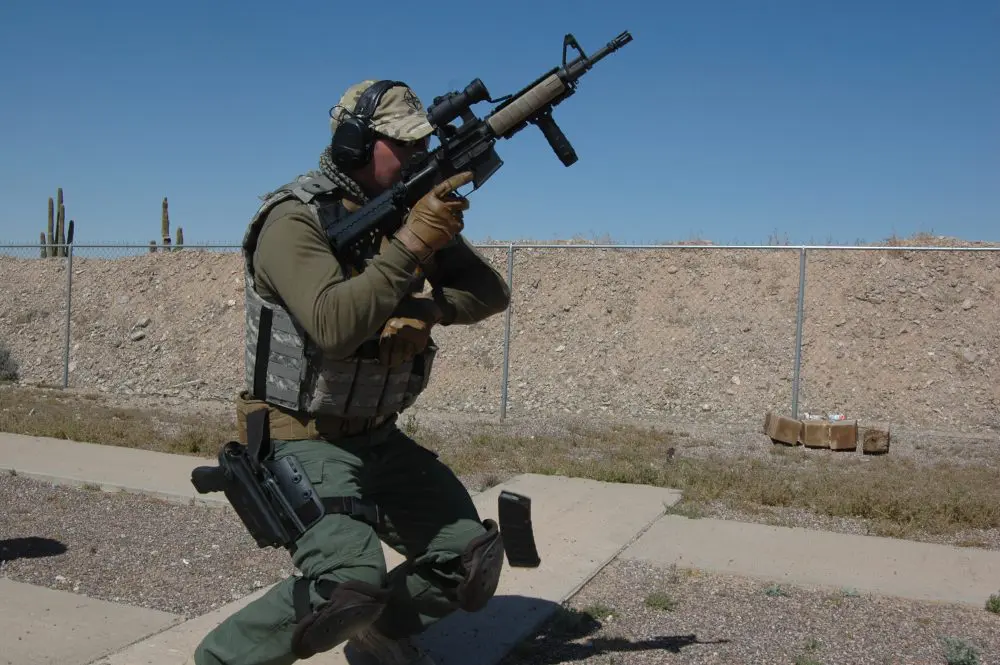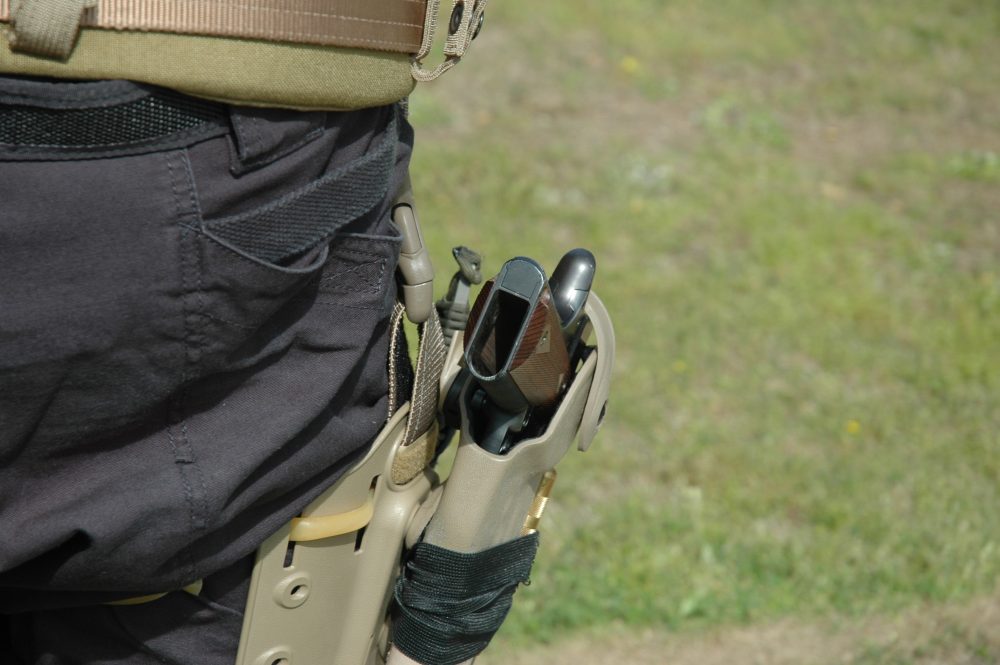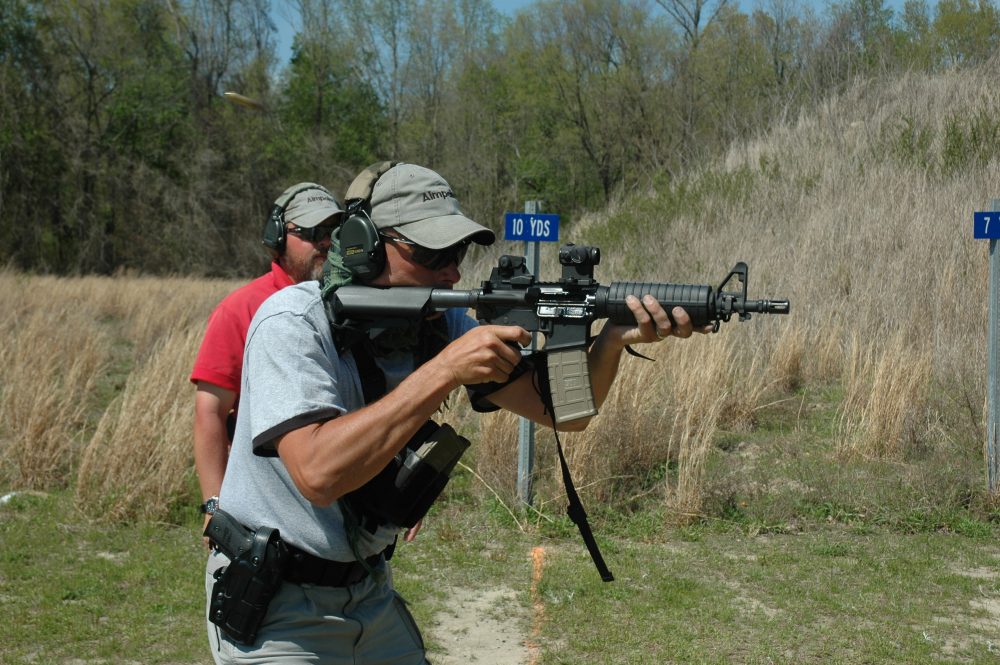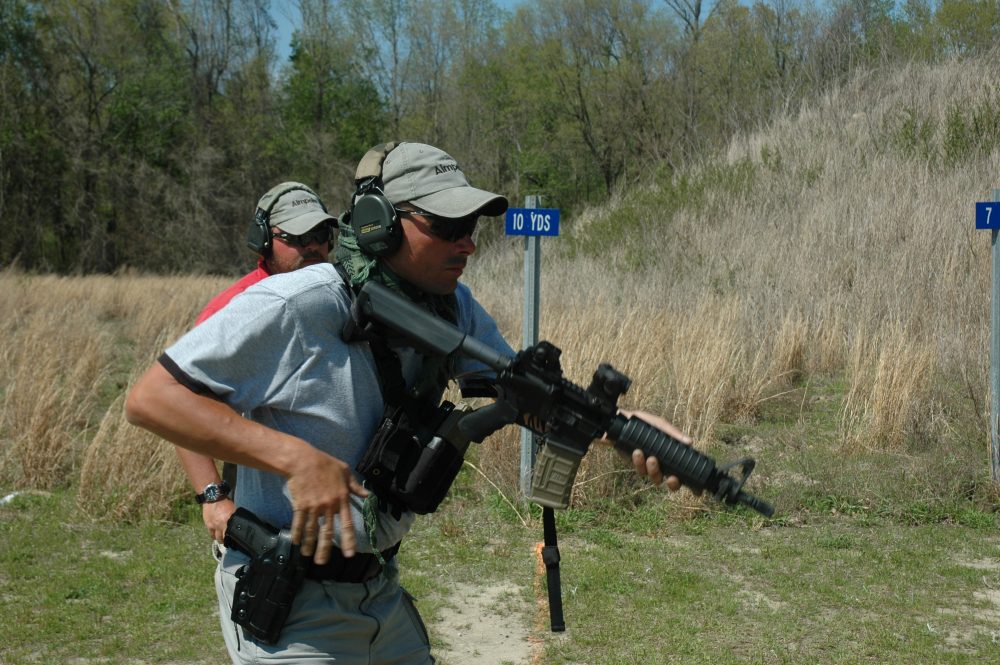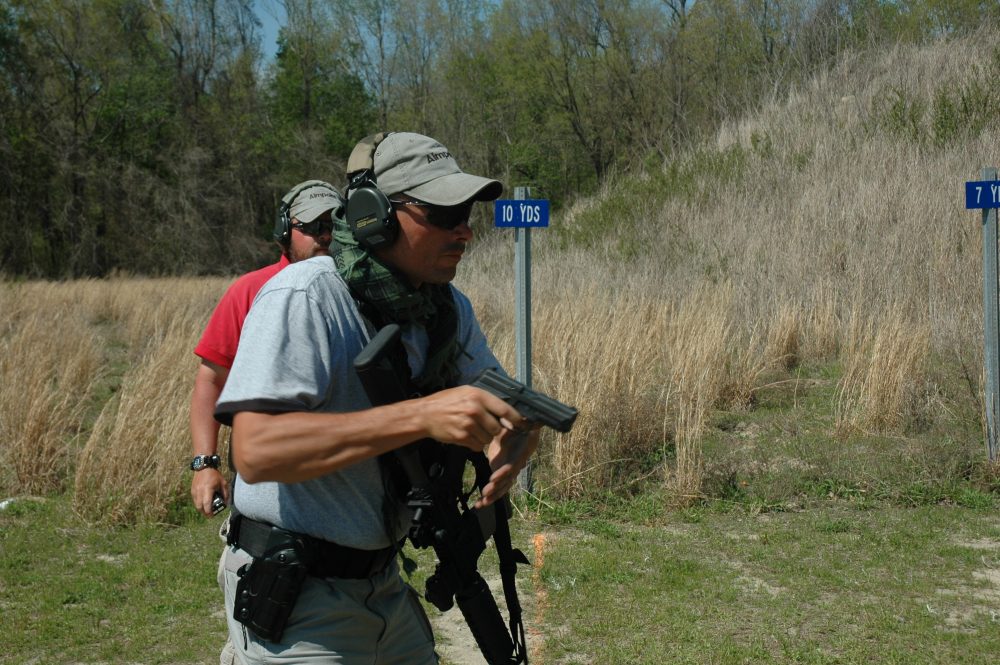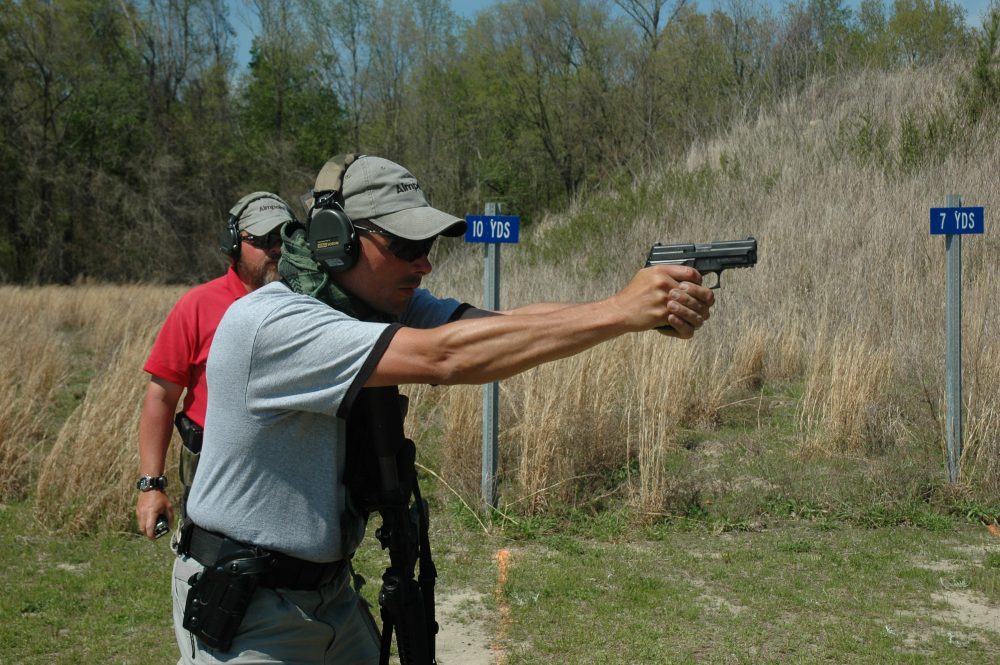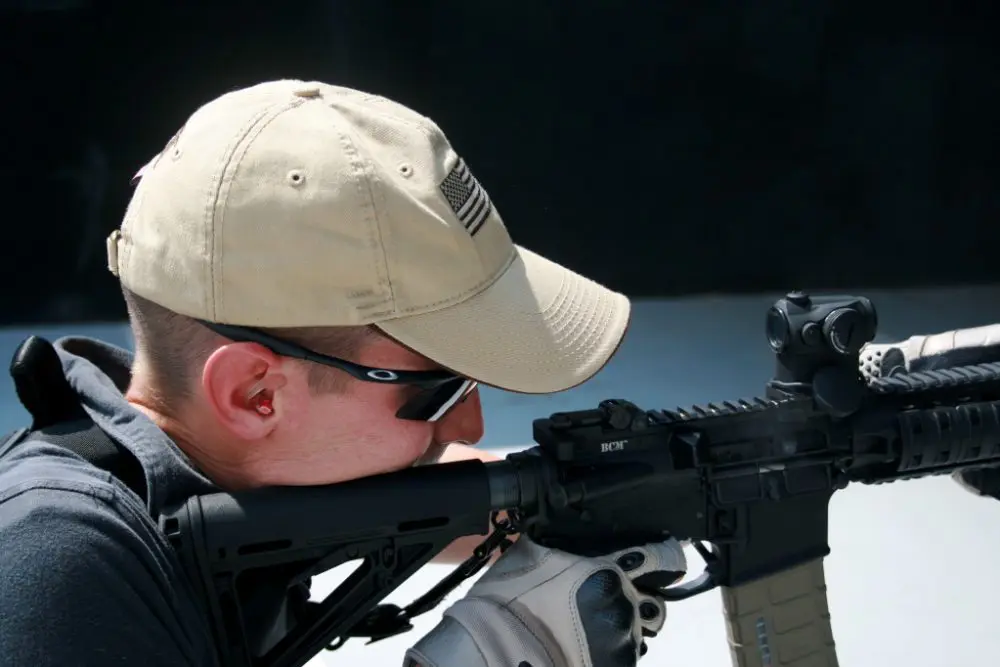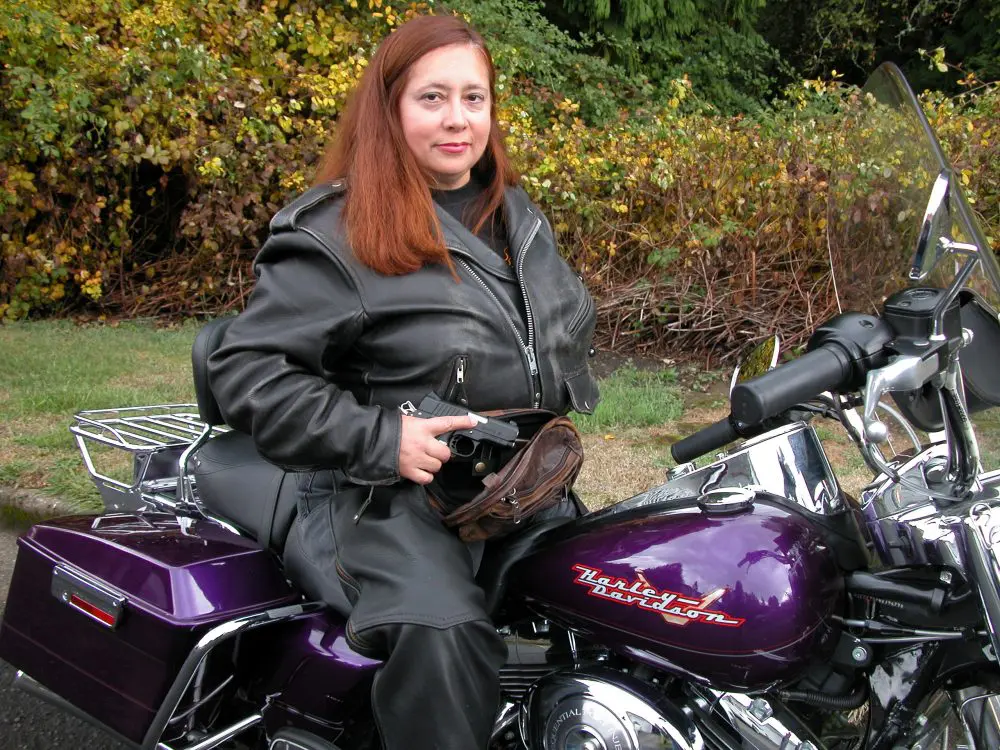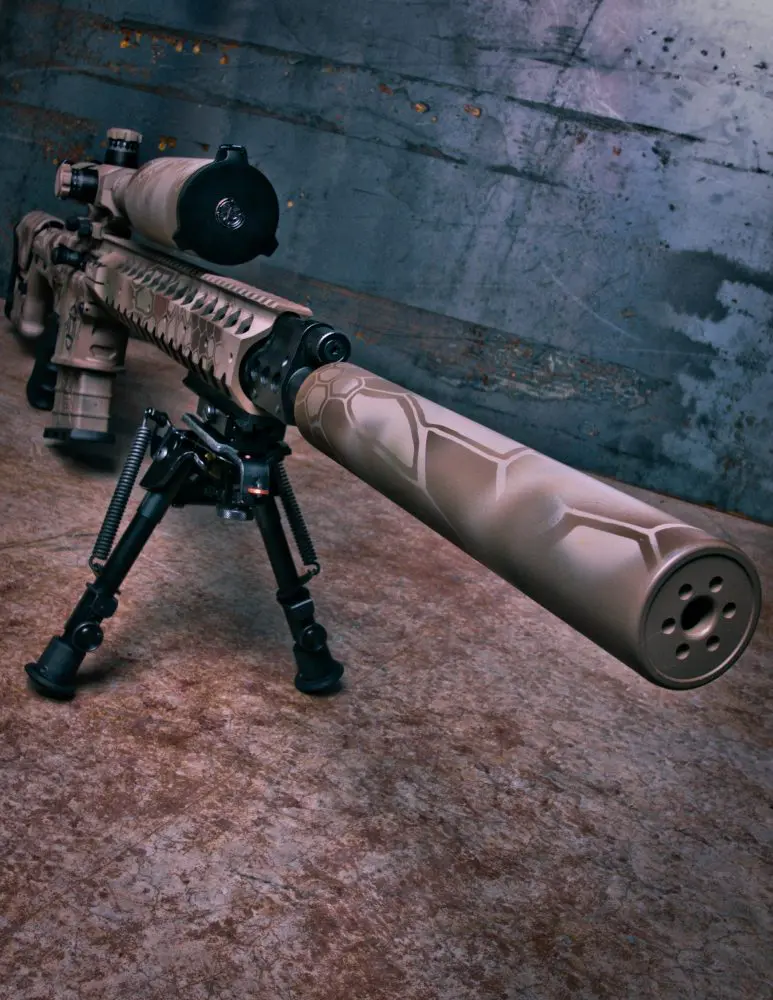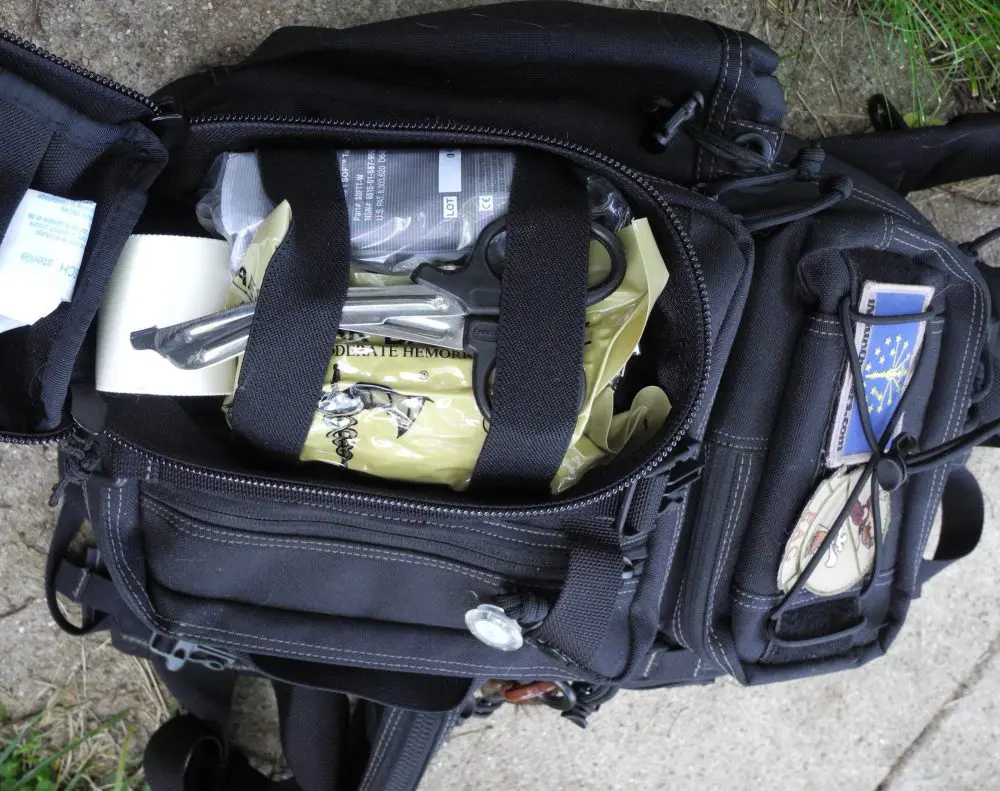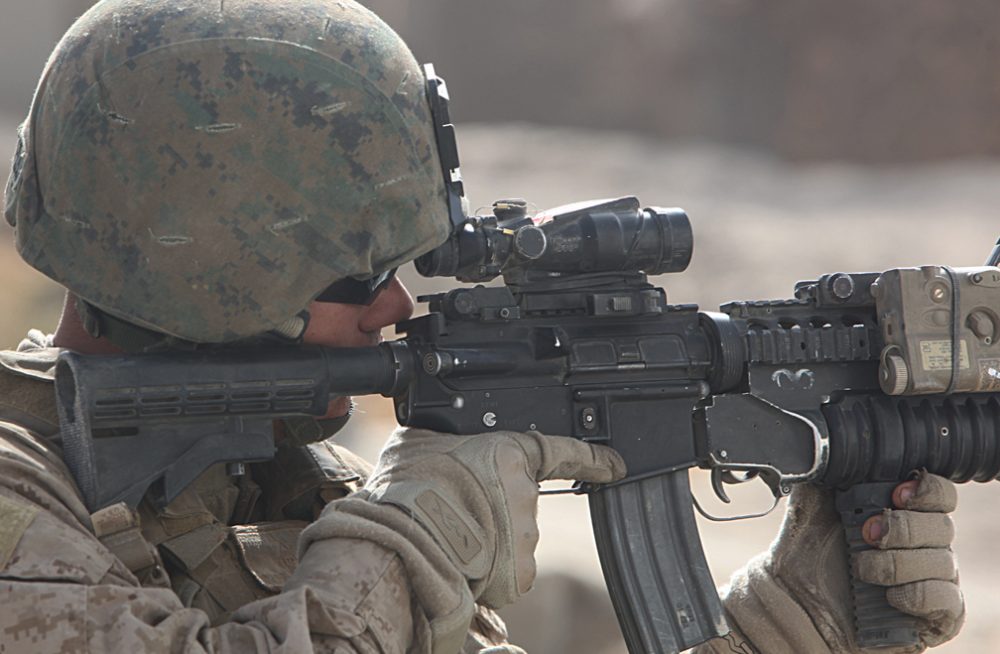Sgt Brian Gragg, Casa Grande, Arizona, PD during timed exercise. He has finished shooting five rounds standing at 50 yards. He is executing a speed reload while going down to Monica. His spent PMAG is headed to the deck, his support-side hand is going for the new magazine, his trigger finger is straight, and he is maintaining visual contact with the target—a time saver when he gets to kneeling. Brian is a solid shooter and a serious gunfighter. He has reached Level 4 of training, where he can do it without thinking about it.
When I was shooting Service Rifle competition, I had a conversation with the Officer in Charge of the Marine Corps Rifle Team, CWO4 Jim Cook. Jim was a former National Service Rifle Champion and had been in charge when the Team swept the National Championships in every category.
While it can successfully be argued that bullseye shooting can teach a lot about marksmanship, it is also a fact that marksmanship is but one-third of the Combat Triad (the other two sides being Manipulation/Tactics and Mindset). However, the discipline required to be a successful champion requires a mindset that has similarities to the discipline necessary to defeat an enemy in the ultimate test.
Jim stated to me, “The real enemy is your mind.” He went on to say that when a shooter cleans the first string of the 200- or 300-yard rapid-fire match, there is no discernible reason why he shouldn’t clean the second part as well. The reason, he explained, was that some personality types just can’t accept success—sort of like snatching defeat from the jaws of victory.
How does this affect those training for the two-way range?
Here is a good example: When a student is told to do a simple task, such as firing a single shot to the brain at 15 yards, almost everyone can accomplish it accurately.
This is especially true if we enforce a time limit. Almost everyone can successfully place that shot inside the brain box of a paper bad guy within two seconds. If, however, we do not enforce a time limit, we see fewer hits.
Why? Probably because shooters over-think the task. We’ll come back to this later. For now, let’s back up for a minute and look at the four levels of learning.
Level 1: Unconscious Incompetence
Level 2: Conscious Incompetence
Level 3: Conscious Competence
Level 4: Unconscious Competence
Make Ready Fail. This very experienced shooter was topping off his pistol mags and came to the line with an unloaded gun. He was given the opportunity to make ready, but skipped over the “fully load the pistol” thing. No matter how long you have been doing this, or how many Cool Guy t-shirts you have, getting down to basics will keep you out of trouble.
Table of Contents
LEVEL 1: UNCONSCIOUS INCOMPETENCE
This is where the student starts. The student isn’t aware of any specific skill set needed to complete an exercise. Or, worse yet, the student may have an overload of pre-conceived notions of how he believes he should react based on years of erroneous input from movies, TV and the dramanet.
An example of this is trigger control. If one doesn’t know how to manage the trigger correctly, he is most likely to lightly touch the trigger once or twice, then take a running start and slap the snot out of it.
If he doesn’t have a clue as to what he is expected to do, he will be unaware of it and will be incompetent when he attempts it. He is unconscious of what is required. He just never does it or even recognizes the need for it.
In Level 1 the student is in Condition White—unaware, fat, dumb and happy.
LEVEL 2: CONSCIOUS INCOMPETENCE
To move to Level 2, the conscious awareness of the skill set required has to occur. The student may have observed others placing their shots where they were told to/intended to. The shooter may now realize that he needs to be paying better attention to the instruction if he is to advance. The student moves from unconscious to conscious by recognizing the skill set exists. When he tries to properly manipulate the trigger on the flat range, he understands that he is not competent. Once he accepts this, he is ready to train to master the trigger. Remember that practice only makes permanent.
To get to Level 3, repetition under supervision must be ongoing. Initial training must be followed by sustainment training.
LEVEL 3: CONSCIOUS COMPETENCE
Once we climb up to Level 3, we can manipulate the trigger properly. We’ll still place too much finger into the trigger guard on occasion, and still slap that bad boy when we should know better. We know how to do it correctly and actually can do it, but generally only do it when we consciously think of doing it or when an instructor tells us to do it.
The skill set doesn’t happen naturally. We have to think of managing that trigger and be conscious of doing it, for the behavior to occur. But we CAN now do it competently, as we have done the required practice and learned conscious competence. Students often think the learning process is now over, but it is not.
Reaching Level 4 requires training to function without conscious thought.
LEVEL 4: UNCONSCIOUS COMPETENCE
To get to this level—where the behavior comes naturally and without thought—requires that the student continue to train, using that skill with repetition under supervision. Eventually the skill set will be used without conscious thought.
This is the beginning of unconscious competence.
Multiple repetitions of the skill set are required to make the jump from Level 3 to Level 4, and that is where sustainment training comes in. At some point, the student will begin to react to the stimuli without conscious thought. The end state is that one is proficient without thinking.
Voila! Learning has occurred.
First rule of gunfighting is to have a working gun in your hands. If the #1 gun goes down, transitioning to the pistol under certain circumstances (specifically distances) is the “A” answer. North Carolina Highway Patrol Trooper J. January starts transition drill. While some consider this to be a complex drill, it is less complex than looking at your downed gun and wishing you were somewhere else while your body is being perforated by the other guy’s bullets.
But it doesn’t stop there. Mastering one tactic, technique or procedure (TTP) gives us exactly one tool for that massive trick bag. What if we have to perform more than one function—and we will. There is precious little in a gunfight that can be rectified with a single act.
At my training outfit, EAG Tactical, we teach via the “crawl, walk, run” methodology. We start off slowly. Once the task is mastered, we increase the complexity, maybe by restricting the time or increasing the number of tasks in a particular skill set.
For example, we teach students to shoot from prone, to shoot from an intermediate position (kneeling or squat), and to execute a speed reload.
We then have them shoot a drill we borrowed from Jeff Gonzales, a Modified Navy Qual. This drill requires them to shoot five rounds standing, speed reload, five rounds kneeling, speed reload and finally five rounds prone, with a par time of 25 seconds. The drill starts off at 25 yards, moves to 35 yards and finally 50 yards, all with the same time restraints. All shots are center mass (eight-inch circle).
He releases his firing grip on the non-working carbine and moves down to the working gun—his pistol. His support-side hand rotates the carbine down and out of the way.
We know they are capable of hitting from standing, kneeling and prone. We know that they can hit after reloading. Now we want to see how they do when they have to perform multiple complex tasks under a time constraint.
And they are doing it individually, hanging out there in front of instructors and peers alike. From a teaching standpoint, it gives us a great opportunity to see every phase of the student’s actions. And of course we see patterns develop. We are often told (by women) that men can’t multi-task. They may be on to something.
When tasked with performing one function—firing five shots center mass from standing, for example—most people will do this handily.
Add a speed reload? No problem for most.
However, if you tack on movement—down to kneeling—while adding a significant time constraint, some start having problems.
His drawstroke is progressing and both hands are coming together. He remains focused on the target. If you have to look at your holster to access the pistol, you need to re-evaluate your training.
The school solution would be to execute the speed reload while on the way down to kneeling. Standing up to reload is wasting time, as is waiting until you get to kneeling to reload. However, a fair percentage of people can’t get their head wrapped around that economy of motion thing. They stand in the middle of Broadway, methodically loading, as the world inexorably passes them by.
Another manifestation of the inability to process complex tasks is that as they go down to kneeling they will do a dance of sorts, taking four or five steps to enter a position that should take a lot less movement to enter. Or they will use one kneeling position to reload and another kneeling position to shoot from. Just wasting time—except that the training is conducted with an eye to that point in time when you have no time to spare.
When you add the final movements—an additional speed reload and then five rounds from prone—many take that step into a parallel dimension.
Even though they perform this drill twice as a relay to work out the hand jive issues, when brought up to do it for score, perhaps five percent will fire the five rounds standing, execute the speed reload, and then go straight to prone.
They are, as the saying goes, overrunning their headlights. That is, they have too much on their plate and are having difficulty deciding what to do first. In short, they are over-thinking the situation. How do we rectify this? Actually, it’s pretty simple.
His transition is complete and he is servicing his target(s). Transition drill requires understanding that if the #1 gun is non-functioning, immediately move the carbine out of the way or discard it if necessary. (It is not necessary to engage the mechanical safety on a non-working gun.) Simultaneously your strong-side hand defeats the holster’s retention mechanism and acquires a firing grip. Two hands come together as you acquire a sight picture and control that trigger straight to the rear—repeat as necessary. While it sounds complex, if you break it down into its component parts, it is not.
Question: How do you eat an elephant?
Answer: One bite at a time.
You have to wrap your head around the fact that this is not one long, complex drill. Instead, break it down into its component parts.
Or as we say during reloading drills, shoot when you are shooting, reload when you are reloading. Don’t mix the two up. If we can successfully separate the parts from one another, we can attack each one separately, therefore simplifying the process. If we operate at that less complicated level, we are more likely to do it efficiently.
At the beginning of this article, we gave an example of shooters being able to make a brain shot better under time constraints than if they had unlimited time. We see this a lot, and it isn’t hard to understand.
We are all familiar with the 7 Ps—an old British Army adage that states Proper Prior Planning Prevents Piss Poor Performance.
Pilots are the kings of preparation, as they clearly understand that many potential operational problems can be identified prior to leaving the surly bonds of earth. When in-flight emergencies occur, they revert to their previous training, and if time permits, have Plastic Brains—checklists—to assist them in dealing with the issue at hand.
Shooters don’t have time to read checklists when an emergency occurs, but they can rely on previous training.
In order for that training to be effective, it must involve repetition under supervision. Self-training is pretty much a myth, and while some good can come from individual practice sessions, unless someone is watching, critiquing and correcting, much of what is done can be a waste of time—or worse, practice to do things wrong.
Using my last Carbine Operators Course at the excellent Gadsden, Alabama Police Range as an example, we had a small and very experienced group of students.
We teach that the command “Make Ready” means protect your eyes, protect your ears, fully load your pistol, load your carbine, and sights on (for those needing to turn on/off their red dots).
We do it that way for a reason. Protecting your eyes and ears first prevents derrière clowns from putting on their protection while holding a pistol in their paw (oh yeah, we have seen it before…). We fully load the pistol because that secondary gun is out of sight and therefore out of mind. Because it can’t be seen, it is often forgotten about.
And lastly we load the carbine. We do it a certain way: feel for the location of the top round in the mag, insert with a push/pull, bolt forward, remove mag and feel for the top round (if it has moved, you have just performed a chambered round verification), reinsert the mag with a push/pull, roll the carbine, glance into the ejection port, and close the dust cover.
Additionally, after each string of fire (and if the tactical situation permits), we teach to roll the gun, look into the ejection port and if all is OK, close the dust cover and engage the mechanical safety.
We teach this because we know it works—at least for the people who understand it. We are building Situational Awareness (SA) not just with our immediate surroundings, but also to create a habitual association with our weapons and support gear.
We enforce this strongly in the beginning, but eventually some will find it too hard to remember, are too cool to train or are just overloaded and forget. Which means they stay stuck in or below Level 3.
At Gadsden on Training Day 2, two experienced shooters came up to the line with their pistols sans magazine. They of course couldn’t notice it, but we sure did and took the pics to prove it—and then ran a pistol drill to enhance the learning experience.
On the very last drill on the last day of the course, the shooter who wound up as High Shooter, a very experienced guy, neglected to push/pull on his magazine, and that full mag fell on the deck. This was but one of six instances where someone neglected to push/pull and had the mag fall out of their stick, but in every other case the shooter (and others) picked up on it.
This was during an elimination, and the shooter was pretty amped up. After he finished firing his single brain shot, he rolled the gun—never looking at it—and closed the dust cover. We moved back to the next yard line and I asked him if he was ready. His steely eyes were focused hard on the target and he nodded affirmatively. When the target faced him, he presented the carbine, pressed the trigger and got a “click.”
Oops…
He lost the bubble. He never looked at the ejection port (the missing mag would have been apparent). His SA was deficient and he failed.
Performing prescribed actions is not the same as performing those actions correctly.
One last manifestation is the most disturbing. Every so often we’ll see someone do something that is off the beaten path. And sometimes that one thing may morph into two or three others, which would draw our attention. When I ask what he’s doing, I’ll hear this: “I don’t know.”
That doesn’t cut it.
He is in a class carrying two loaded guns, and in proximity to a number of others also carrying loaded weapons. “I don’t know” means that he has become Bambi—a deer in the headlights. Over-amped and out of control.
Anytime you strap a gun on, it carries with it legal, moral and ethical responsibilities. “I don’t know” means that you do not have the proper mindset.
We have choices. We may never do everything correctly, but we need to strive to keep the dumb moves to an absolute minimum.
We often believe that we can train our body to do great and wonderful things. What we really need to do is train our mind to make our body operate at speed, under adverse conditions, and to fight until we win.
Being at Level 4 of training means we can function correctly without conscious thought. Not having to think about it means we can accomplish our goals faster—and available time in a gunfight is always in short supply.
A wise man once stated that, “Amateurs train until they do it right. Professionals train until they can’t do it wrong.”
At that point learning has occurred.
[Pat Rogers is a retired Chief Warrant Officer of Marines and a retired NYPD Sergeant. Pat is the owner of E.A.G. Inc., which provides services to various governmental organizations. He can be reached at [email protected]]
